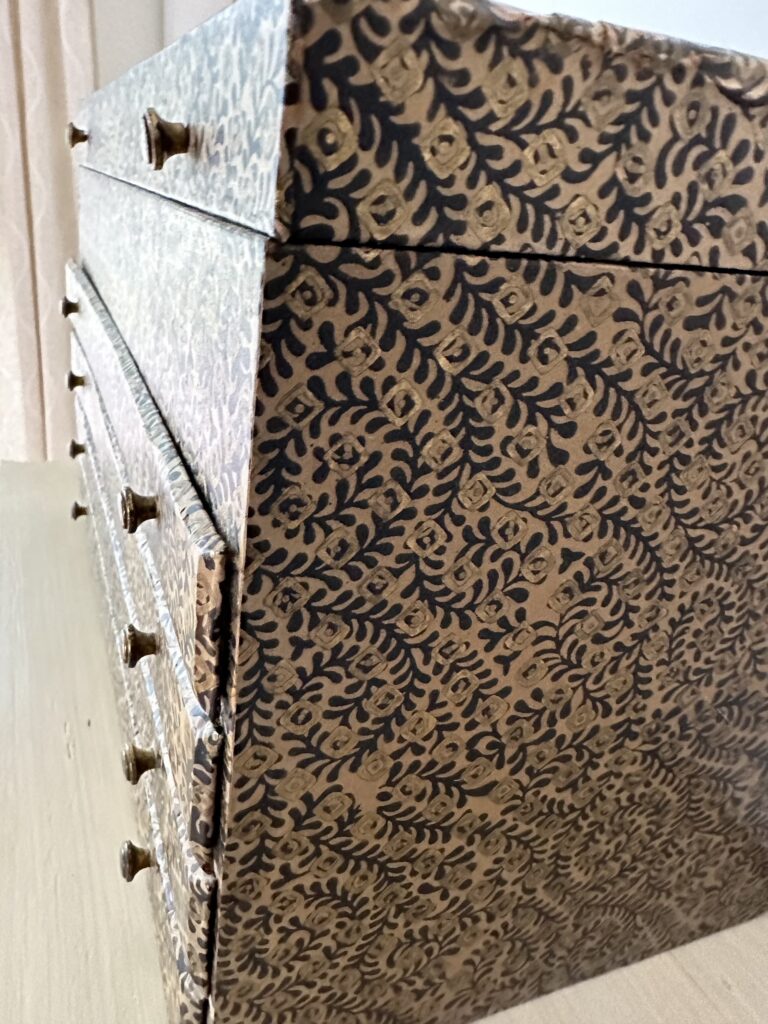Ask my friends and they’ll tell you I’m often on a quest to make something I’ve never tried before. Usually, they’ll say, “Now, how did you know how to do that?” My usual response is, “I just figured it out. …” meaning by hook or crook and a whole lot of Youtube videos, I taught myself the basic technique and then modified it to suit my needs. On one project focusing on repurposing with wabi-sabi vibe, I integrated several techniques.
Turning kitschy into elegant
One of my favorite things I’ve made is a jewelry box that continues to give me daily pleasure. I love its wabi-sabi vibe. It all started when I found a tacky 1950-ish, vinyl-covered jewelry box in a local thrift store. The box, complete with three drawers and an atrocious red velvet lining, cost me a whopping $2.50. It measures 18” wide x 18” tall x 12” deep and is actually more of a chest than a box. As soon as I saw it, I envisioned it as an elegant beauty. My plan was to transform it into a jewel of a box by covering it in Japanese book-binding paper.
It’s been completed now for many years. It turned out well and even its flaws add to its wonderful sense of having timeless grace and beauty in imperfection. It’s so timeless that over the years, it’s fit beautifully with all of my changing style preferences. So timeless it equally can be the centerpiece of my bedroom, or quietly create its own hygge.

“Naturally, it didn’t turn out perfectly, but I’ve never minded that; the imperfections have always felt in keeping.”
Repurposed jewelry box covered in book-binding paper
Japanese book-binding paper
Years ago when I lived in Chicago, I wandered into an amazing paper store near the loft space where I worked on Institute Place. Darn, I wish I could remember the name — I think it was Paper Source, but I could be wrong. Their collection of bookbinding papers was stunning and my creativity barometer started quivering. After agonizing over my pattern choice, I selected one that looked like it had been hand block-printed with loose burnished gold and geometric shapes on a leafy navy background.

I had never used book-binding supplies but was super intrigued with the possibilities. I remember asking the staff for tips and bought all of the materials I’d need, including several large sheets of the paper, a real bone folder to make clean folds, decoupage type glue, and acrylic clear matte gesso to protect the paper from wearing, fading and aging. (I can vouch for using this protective method. The jewelry box has withstood time beautifully, including numerous moves and the curious explorations of children!)

When is the right time to start?
I was primed to start immediately, but wouldn’t you know it, life got more complicated and I found myself relocating several times. One of those times involved moving to North Carolina. Each time, I schlepped the bookmaking supplies until I could foresee enough time to start and finish the project. Four years later I grabbed an opening . …
Measure twice, cut once
My plan was to recover the entire outside of the box, along with the inside of the hinged lid, in as few pieces as possible. I figured this would ensure a smooth flow around the contours, rather than inadvertently creating corner butts that could separate and lift with wear.
Limiting the number of pieces meant that I’d need to measure and mark the dimensions carefully on the paper and cut openings where the drawers would fit. I anticipated folding the cut margins inward using the new bone folder.
If you can envision the precision needed to cut drawer openings from a single piece of paper that will be wrapped around the object, you’ll get the idea of my technique.
First, I removed the drawers and their separate facades, leaving its vinyl surface intact. I also left the lid hinges untouched to avoid damaging the hardware. Next, on the backside of the paper, I measured and marked in pencil all of the cut and fold lines, including a 1/4-3/8 inch margin wherever I wanted the paper to wrap around a corner or fold inward. The trickiest part was on the interior of the lid where I ran the paper uninterrupted from the outside to the inside, with miters on the external and internal corners. I’m sure there were easier ways to do it but none caught my fancy at the time.

The art of gluing
As with many projects involving gluing, there’s a benefit to adding the glue to both surfaces for the best contact. Starting with the paper section I designated for the front of the box, I prepped the surface with glue. Keep in mind that I already had folded the edges with the bone folder where I knew they would wrap. These cuts and folds helped give the paper a bit of structure as I wrapped it instead of it tending to re-roll.
I used a brush to layer the glue on the surfaces, starting with the box’s surface. Then, I added glue to the wrong side of that paper section. Next, and oh so carefully, I positioned the section and pressed carefully while aligning corners and openings. I covered the outer lid and its interior surfaces and finally the drawer facades.



I absolutely love the way the jewelry box turned out and have displayed it prominently in my bedroom for more than 25 years. It set a gold standard for me in my practice of repurposing with wabi-sabi vibe. Naturally, it did not turn out perfectly, but I’ve never minded that; the imperfections have always felt in keeping.
Each day, I stand in front of the box to select my jewelry, thinking about it’s natural beauty and how rewarding it was to bring forth something with soul from such a tacky origin. At the end of each day, I return the jewelry to their nesting places, like birds returning to a home sanctuary. It’s a ritual, steeped in the imperfection of wabi-sabi. It brings me simple pleasure.
Copyright 2023-2024 Driftwilde | Privacy Policy | Disclaimer | Terms and Conditions